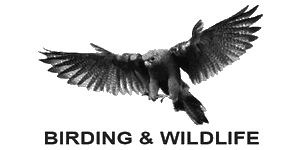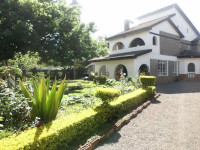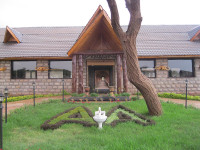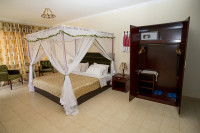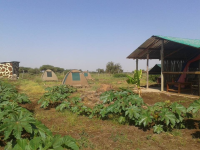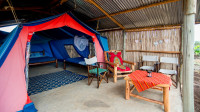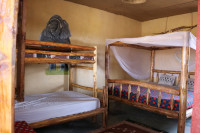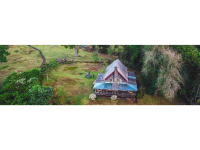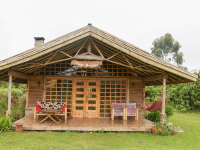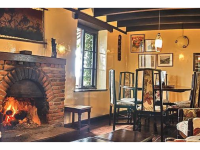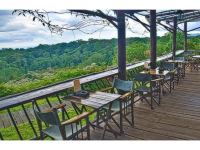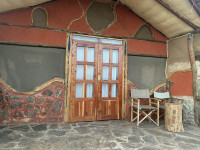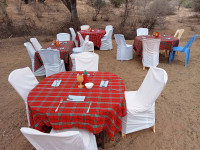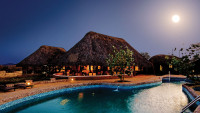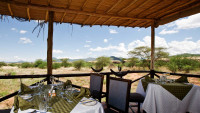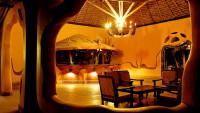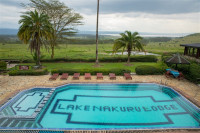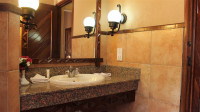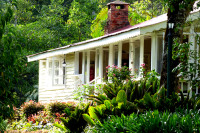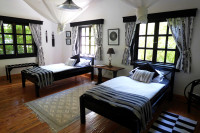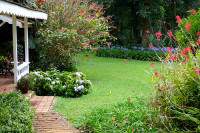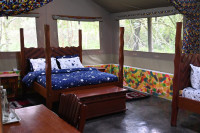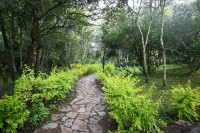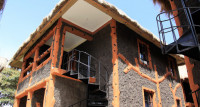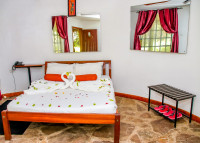
$6,973 pp (USD)
2 travelers on Start dateArrival
Arrival

Day 1
Nairobi National Park
Nairobi National Park
The park lies at the center of Nairobi city and is fenced to protect wildlife from direct contact with humans. The southern boundary is open to allow migrating wildlife to move between the park and the neighboring Kitengela plains. From big ungulates to the smallest like rodents and chameleons, over 500 species of birds live in the park. You will see Von der Decken’s hornbill, common ostrich, black-headed heron, marabou stork, Egyptian goose, black-shouldered kite, African white-backed vulture, augur buzzard, tawny eagle, helmeted guineafowl, the beautiful grey crowned crane, white-bellied bustard, ring-necked dove, white-browed coucal, rufous-naped lark, red-rumped swallow, rock Martin and the multicolored red-and-yellow barbet, or our first flamingos among many wintering Palearctic shorebirds on Lake Magadi.
- Main Destination:
- Nairobi National Park
- Accommodation:
- Hotel Troy
- Meals & Drinks:

Day 2
Birding at Tsavo West National Park
Birding at Tsavo West National Park
This is the biggest national park in Kenya and among the top 10 biggest in East Africa. It is strategically located between the two capital cities of Kenya —Nairobi and Mombasa. It is one of the oldest parks in Kenya with an enormous wilderness area that was divided into two sections i.e. Tsavo East and Tsavo West National Parks.
- Main Destination:
- Tsavo West National Park
- Accommodation:
- Ngulia Safari Lodge
- Meals & Drinks:

Day 3
Full-Day Birding and Wildlife Experience in Tsavo West National Park
Full-Day Birding and Wildlife Experience in Tsavo West National Park
You'll try your luck for cut-throat finch, golden-breasted starling, African bare-eyed thrush, Irania, quail-plover, Pangani longclaw, Abyssinian Scimitarbill, violet wood-hoopoe, southern ground hornbill, spotted eagle owl, long-crested eagle, square-tailed nightjar, Somali long-billed crombec, the Eastern paradise, steel-blue, and straw-tailed Whydahs, scaly chatterer, spotted eagle-owl, spotted flycatcher, vulturine guinea-fowl, crested francolin, red-chested cuckoo, black-cuckoo shrike, Eurasian and black-headed orioles, gabar goshawk, three-streaked Tchagra, Eastern violet-backed, and variable sunbirds, red-fronted warbler, green-winged Pytilia, white-headed and blue-napped mousebirds, sulfur-breasted bush-shrike, red-billed and yellow-billed oxpeckers, black-fronted bush shrike, yellow-throated woodland warbler, yellow-bellied and striped-cheeked greenbuls, white-starred robin, the national Taita thrush, Taita white-eye, Taita Apalis and a few more.
- Main Destination:
- Tsavo West National Park
- Accommodation:
- Ngulia Safari Lodge
- Meals & Drinks:

Day 4
Birding at Amboseli National Park
Birding at Amboseli National Park
You will enjoy a great birding experience with the breathtaking backdrop of Mt Kilimanjaro, comprising of plains, woodlands, and rocky thorn bush. Elephants and other animals viewing, annual wildebeest migration can also be encountered here. It is quite a long day's drive with several stops to scan around.
- Main Destination:
- Amboseli National Park
- Accommodation:
- Aa Lodge Amboseli
- Meals & Drinks:

Day 5
Birding and Game Drives in Amboseli National Park
Birding and Game Drives in Amboseli National Park
You'll have a chance to see the Taveta golden weaver, long-toed plover, red-throated tit, collared pratincole, Fischer’s sparrow lark, black-necked weaver, Fischer’s starling, greater spotted eagle, Caspian plover, yellow-throated sandgrouse, black-faced sandgrouse, capped wheatear, lead-colored flycatcher, the skulking Aberdare cisticola, golden-winged sunbird as well as eastern double-collared, tacazze and malachite sunbirds, scarlet-tufted malachite sunbird, Alpine chat, rufous-breasted sparrowhawk, dusky turtle dove, scarce swift, cape wagtail, cape robin-chat, Abyssinian ground thrush, chiffchaff, hunter’s cisticola, mountain yellow warbler, slender-billed starling and Kandt’s waxbill, and many more. Over 450 species are known to occur here.
- Main Destination:
- Amboseli National Park
- Accommodation:
- We4Kenya Guesthouse
- Meals & Drinks:

Day 6
Transfer to Mount Kenya, Castle Forest
Transfer to Mount Kenya, Castle Forest
You'll reach here and go birding in the evening. In Mount Kenya, you'll look for silvery-cheeked hornbill, Hartlaub’s turaco, Rueppell’s robin-chat, mountain yellow warbler, and yellow-crowned canary. The lodge’s waterhole attracts many mammals including African buffalo. You’ll spend the early mornings searching for white-starred robin, Abyssinian crimson-wing, African crowned eagle, African emerald cuckoo, and mustached green tinkerbird. A shaded riverside trail may reveal crowned hornbill, mountain wagtail, and up to eight species of sunbirds, including the stunning tacazze sunbird.
- Main Destination:
- Mount Kenya
- Accommodation:
- Castle Forest Lodge
- Meals & Drinks:

Day 7
Birding and Wildlife Castle Forest, Mount Kenya
Birding and Wildlife Castle Forest, Mount Kenya
Castle Forest, nestled in the heart of the countryside, offers a serene haven for birding enthusiasts. Its diverse ecosystem, comprising ancient woodlands, sprawling meadows, and crystal clear streams, supports a rich variety of avian diversity. The forest's towering castles of oak and pine provide ideal nesting and roosting sites for a myriad of species, from majestic eagles to colorful songbirds. As you stroll along the winding paths, the air is filled with the melodies of warblers and the occasional call of woodpeckers echoing through the canopy. Nature enthusiasts and photographers alike are drawn to Castle Forest for its serene beauty and abundant wildlife. Whether you're a seasoned birder or a casual observer, the forest's peaceful ambiance and rich biodiversity promise an unforgettable birding experience.
- Main Destination:
- Mount Kenya
- Accommodation:
- Castle Forest Lodge
- Meals & Drinks:

Day 8
Transfer to Samburu National Reserve
Transfer to Samburu National Reserve
Samburu National Reserve, nestled in northern Kenya, is a stunning landscape of rugged savannahs, acacia forests, and meandering rivers. Renowned for its unique wildlife and dramatic scenery, Samburu is home to species not often found elsewhere, such as the reticulated giraffes, Grevy's zebras, and the Somali ostriches. The park's diverse habitats offer rich opportunities for wildlife viewing and photography. Elephants roam freely along the Ewaso Nyiro River, while leopards and lions prowl the rocky outcrops. Birdwatchers can spot over 450 bird species, including the vibrant vulturine guineafowl and the striking martial eagle. Cultural encounters with the Samburu people, who have lived in harmony with the land for generations, add a unique dimension to a visit. Accommodation ranges from luxury lodges to tented camps, ensuring a comfortable stay amid the wilderness. Samburu National Reserve promises an unforgettable safari experience.
- Main Destination:
- Samburu National Reserve
- Accommodation:
- Lion's Cave Camp
- Meals & Drinks:

Day 9
Birding and Wildlife at Samburu National Reserve
Birding and Wildlife at Samburu National Reserve
You'll enjoy birding at Samburu National Reserve and Buffalo Springs. You'll look for white-headed and blue-napped mousebirds, sulfur-breasted bush shrike, red-billed and yellow-billed oxpeckers, black-fronted bush-shrike, yellow-throated woodland warbler, yellow-bellied and striped-cheeked greenbuls, white-starred robin, the national Taita thrush, Taita white-eye, Taita apalis, Ayres’s hawk-eagle, tawny, steppe, imperial, martial and Wahlberg’s eagles, Egyptian vulture, bateleur, black-shouldered kite, barbary falcon, the grey and common kestrels, red-winged Llark, Somali and temminck’s coursers, crested francolin, white-bellied and buff-crested bustard, Somali ostrich, olive-tree warbler, red-billed buffalo weaver, northern pintail, red-billed teal, fulvous whistling, white-faced whistling ducks, common sandpiper, and collared pratincole.
- Main Destination:
- Samburu National Reserve
- Accommodation:
- Samburu Sopa Lodge
- Meals & Drinks:

Day 10
Transfer to Lake Nakuru National Park and Birding from Afternoon to Evening
Transfer to Lake Nakuru National Park and Birding from Afternoon to Evening
A birding tour at Lake Nakuru promises a spectacular experience for enthusiasts and nature lovers alike. Located in Kenya's Great Rift Valley, Lake Nakuru National Park is renowned for its breathtaking scenery and diverse birdlife. The lake itself is a haven for millions of flamingos, creating a stunning pink-hued spectacle against the backdrop of the lake's waters. Apart from flamingos, the park boasts over 400 bird species, including pelicans, cormorants, herons, and many more. The surrounding acacia forests and grasslands provide additional habitats for a variety of bird species, making it a paradise for birdwatchers and photographers. Guided tours offer insights into the behaviors and habitats of the birds, as well as opportunities to spot other wildlife such as rhinos, giraffes, and leopards. Whether you're a novice or an experienced birder, a visit to Lake Nakuru promises a memorable adventure in one of Africa's most iconic birding destinations.
- Main Destination:
- Lake Nakuru National Park
- Accommodation:
- Lake Nakuru Lodge
- Meals & Drinks:

Day 11
Birding and Wildlife Lake Nakuru National Park and Transfer to Kakamega Forest
Birding and Wildlife Lake Nakuru National Park and Transfer to Kakamega Forest
While at Nakuru, you will awaken to vast flocks of flamingos, pelicans, and other water birds. The surrounding woodland holds Narina trogon, red-throated wryneck, arrow-marked babbler, African firefinch, African skimmers, dub-chicks, and other mammals.
- Main Destination:
- Lake Nakuru National Park
- Accommodation:
- Rondo Retreat
- Meals & Drinks:

Day 12-13
Birding and Wildlife at Kakamega Forest National Reserve
Birding and Wildlife at Kakamega Forest National Reserve
Kakamega is full of birds and is famous as one of Kenya’s birding meccas. Many of Kenya’s fantastic forest birds are available only here. This morning, you will check out and enjoy birding en route to the highly-rated forest birding destination in Kenya.
At Kakamega, you will search for white-chinned and banded prinias, Jameson’s and yellow-bellied wattle-eyes, Bocage’s and Luehder’s bushshrikes, black-billed and Vieillot’s weavers, gray-headed negrofinch, red-headed Malimbe, red-headed bluebill and much more.
- Main Destination:
- Kakamega Forest National Reserve
- Accommodation:
- Rondo Retreat
- Meals & Drinks:

Day 14
Transfer to Masai Mara National Reserve and Afternoon Game Drive
Transfer to Masai Mara National Reserve and Afternoon Game Drive
Masai Mara National Reserve, located in southwestern Kenya, is a world-renowned safari destination known for its abundant wildlife and stunning landscapes. It forms part of the larger Serengeti ecosystem, famous for the annual wildebeest migration, a natural spectacle of epic proportions. The reserve is home to an impressive array of wildlife, including the Big Five (lion, elephant, buffalo, leopard, and rhinoceros), as well as cheetahs, hyenas, giraffes, zebras, and various antelope species. Birdwatchers will delight in spotting over 450 bird species, from colorful lilac-breasted rollers to predatory martial eagles. Game drives offer intimate encounters with wildlife against the backdrop of sweeping savannahs, dotted with iconic acacia trees.
- Main Destination:
- Masai Mara National Reserve
- Accommodation:
- Drunken Elephant Mara
- Meals & Drinks:

Day 15
Transfer to lake Naivasha area- for Kinangop Grassland
Transfer to lake Naivasha area- for Kinangop Grassland
You’ll spend the whole morning driving while birding to Lake Naivasha area. The target is to reach here on time and bird at Crater lake sanctuary as you prepare for the next day in the grasslands. The birds to pick here are mostly water related species and woodland species.
- Main Destination:
- Lake Naivasha (Naivasha)
- Accommodation:
- Dove Nest Lodge
- Meals & Drinks:
Day 16
Birding at Kinangop grasslands in the morning before you transfer to Nairobi for your return flight
Birding at Kinangop grasslands in the morning before you transfer to Nairobi for your return flight
Your target will be the endemic Sharp's Long-claw, and other interesting species like Golden-winged sunbird, Jackson's, Long-tailed widowbird, Yellow-mattled Bishop and more other interesting species. Later you will drive for about 3-4hours to Nairobi for your return flight. And that will mark an end of your tour.
- Main Destination:
- Kinangop Grasslands
- Accommodation:
- No accommodation (End of tour)
- Meals & Drinks:

